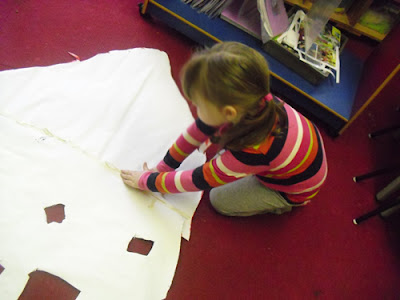This project all started from this one inspiration at the Duplo on Monday. A few children were building houses and I asked them what their houses were like and this attracted a lot of attention and interest. I also asked about different rooms in their houses, but I quickly realised that this was met with some confusion and lack of understanding. Rooms? I got answers like "teddy bear," and "I have a doll." Hmmm. Guess we don't really understand the concept of a room. When I said words like "kitchen" and "bedroom," the children began to understand a bit better. The next day, we put out a resource that the children could play with to explore different rooms in their homes. I don't have a photo of it, but it's essentially like a doll's house, but separate boxes to act as rooms, and the children set up the furniture and characters appropriately.
Next, we looked at photographs of different types of homes in their community. There was a lot of interest as they recognised buildings and houses like their own, and we discussed things like the shapes, colours, and what they're made of. From there, we began our project of making a house.
One child drew a big square after discussing what shape the house should be. Next, several children helped cut along the lines.
This was a great way for me to assess some of the children's scissor skills. I also made sure that children had appropriate scissors for their developmental level. You'll notice that some of them have spring scissors while others have regular children's scissors where they operate them by opening and closing.
Next, we had a discussion about how we should colour the house. Most children agreed that we should use paint. I asked them what we should use to paint it because a house wall isn't always smooth. There was some confusion, so to help them understand we went outside to look at and feel the texture of the wall on the outside of the school.
Some children said, "bumpy," "rough, "ouch!" and "spiky." When we went back inside, we looked at some of the things we could use to make the house look like those words. We found gloves that have textured materials attached to them and we all agreed that they would make our house look bumpy.
When our house dried, we talked about what elements it should have. They all agreed that we needed windows and a door, so we got to work. Again, this was a great opportunity to see some scissor skills in action. Throughout this project, I had children dropping in and out, so I always had different helpers.
Next, we painted the door blue. We used rollers because that's what "house painters" use.
Throughout this project, we had been looking at photographs of houses for reference. The children noticed that there was white trim around the windows and doors. We discussed what they might be called, but they didn't know, so they learned two new terms: "window frame" and "door frame." They used the rollers to add this to their house as well.
In some of the photographs, the children noticed a "fence" or the porch and they wanted to add that as well.
Finally, the children discussed their need for a triangle roof. They drew the shape, cut it out, and painted it red. One of the children said as they were rolling, "It feels like I'm painting a real house."
When everything was dry, two helpers attached the square house and triangle roof using sticky tape.
Sadly, I forgot to take a photo of the finished product up on the wall! I assure you, it looks fab because the children did it all by themselves with only verbal guidance and prompts from me. After we hung it on the wall, some of the kids made labels so that visitors will know what all the parts of a house are.
There are so many things we can do from this project, and I'm hoping it's not over yet. As you can see, this interest has already made its way into other areas of their learning:
And all from this one little model:






















